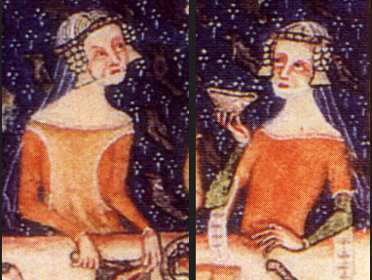Women in the Middle Ages

Table of Contents
- Influence of the Roman Catholic Church on Women's Position in the Medieval Society
- Peasant Women
- Noble Women
- Medieval Marriages
- Medieval Women in the Service of the Roman Catholic Church
- Women in Medieval Towns and Cities
Quick Facts
The main role of women in the Middle Ages was to run the household and raise children.
The position of women in the medieval society was greatly influenced by the views of the Roman Catholic Church.
Women were taught to be obedient to their husbands.
An average peasant women married at the age of 14 and gave birth to the first child at the age of 15.
Some noble women gained great influence but medieval queens regnant were the exception rather than the rule.
Medieval marriages were arranged by the parents and were often marked by absence of love.
Women in the service of the Roman Catholic Church could only be nuns or in best case abbesses.
Women from wealthy merchant families dedicated themselves almost exclusively to the role of a wife and mother.
Women from the working class actively contributed to the family's income but they were paid less than men.
Influence of the Roman Catholic Church on Women’s Position in the Medieval Society
The perception of gender roles in medieval Europe was greatly influenced by the Roman Catholic Church which did not present women in the best light. The Church considered women to be responsible for the original sin or the Fall of Man on the basis that a woman – Eve persuaded Adam to eat the fruit from the forbidden tree of knowledge which resulted in the expulsion of man from paradise.
Women’s image in the eyes of the Church improved slightly after the emergence of the cults of the Blessed Virgin Mary and Mary Magdalene in the 12th and 13th centuries but only for a short time. The end of the Middle Ages saw the beginning of witch-hunts which reached their height in the Early Modern Period. Thousands of people were executed for witchcraft, while about 80 percent of the victims of this mass hysteria were women.
Peasant Women
Peasant women had a considerable equality within their social class although this equality was mostly limited to labor on the field rather than marriage. All women were taught to obey their fathers and later husbands although they probably did not allowed themselves to be ordered around, at least not all of them. An average peasant woman married at the age of 14 and gave birth to the first child at the age of 15. Mortality rate at childbirth was extremely high and as a result, many women died before the age of 25.
Noble Women
Unlike peasant women, noble women were often shown a lot of respect although they usually had no say in the decisions of their husbands. However, some had a great deal of influence especially those who belonged to high nobility or royalty. Queens regnant (ruling queens) were the exception rather than the rule, however, it was not unusual for queens to act as regents to their underage sons. Noble women could also inherit titles and estates from their fathers (of course, if they did not have legitimate brothers) but the title and their right to the land passed to their husbands upon marriage.
Medieval Marriages
Despite the fact that the troubadour poetry puts a major emphasis on courtly love, love had little to do with marriage in the Middle Ages. Just about all marriages were arranged by the parents or guardians in all classes of medieval society, while the children were not asked for their opinion and wishes. Rather than a union between a man and woman who are in love, marriage was perceived as an instrument to extend the wealth and influence of the family especially by the medieval social elites. The lowest classes of the medieval society, on the other hand, were happy for having one hungry mouth less to feed.
Medieval Women in the Service of the Roman Catholic Church
The Roman Catholic clergy, a highly respected and influential class of the feudal society in the Middle Ages was organized into a strict hierarchy which excluded women completely from the highest structures. Female members of medieval clergy were almost exclusively nuns, while the highest status they could achieve was the position of an abbess or superior of the abbey or monastery. This position, however, gave them a significant influence although it cannot be compared with the influence of priests, bishops and deacons, offices which were and still are closed for women.
Women in Medieval Towns and Cities
The role and life of women in medieval towns and cities depended greatly on their social status. Women who originated from wealthier merchant families usually dedicated themselves to running the household and raising children, while those from less wealthy families were expected to help in the family business. Women from the working class mostly worked as spinners, saleswomen and bakers, however, they were often forced to work in physically demanding jobs for lower wages than men.




